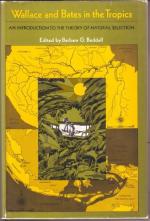|
This section contains 388 words (approx. 2 pages at 300 words per page) |
World of Genetics on Henry Walter Bates
Henry Walter Bates, an early supporter of Charles Darwin (1809-1882) and the first scientist to offer an explanation of mimicry, was born in Leicester, England, the son of a hosiery manufacturer. Despite his outstanding school record and keen intellectual interests, he became a hosiery apprentice in 1838, but continued to study academic subjects at night. Entomology was his hobby. He published his first scientific paper when he was only eighteen.
The young Bates worked as a clerk but longed to escape the business world. When he met Alfred Russel Wallace (1823-1913), the master of the local Collegiate School, in 1844, he saw his chance. The pair became fast friends, especially after Bates sparked Wallace's curiosity about insects. Together they set sail in 1848 to gather specimens in the Amazon basin. Wallace left in 1852, but Bates stayed until 1859, making trips as deep as 2000 miles into the unspoiled jungles of Brazil.
Arriving back in England the same year that Darwin's Origin of Species appeared, Bates immediately embraced Darwinian evolution and set about trying to understand the specimens he had collected in South America in terms of this new theory. His results were very significant. In a classic paper on Amazon butterflies presented in November 1861 and published in the 1862 Transactions of the Linnaean Society of London, Bates coined the term "mimicry" and proposed the first comprehensive theory of this phenomenon, in which a dangerous, strong, or inedible species serves as the model for a harmless, defenseless, or tasty species to imitate its appearance and thereby protect itself. This one-to-one relationship between model and mimic, called "Batesian mimicry," held sway for about twenty years until Fritz Müller (1822-1897) suggested that a multilateral protective relationship also exists among otherwise unrelated mimics.
Bates's work on mimicry went far toward supporting Darwinism in general and the theory of natural selection in particular. Darwin himself was thrilled, and Bates, who had just been passed over for appointment to a prestigious zoological position at the British Museum, was soon rewarded with high offices in the Royal Geographical Society and the Entomological Society of London. He became a fellow of many prominent scientific societies, including the Royal Society. Brazil decorated him with the Order of the Rose. Although he never produced any other groundbreaking scientific work, his honors were undiminished when he died in London at age 67.
|
This section contains 388 words (approx. 2 pages at 300 words per page) |


